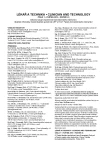Testing of automatized rehabilitation device designed for elderly by industrial robot
Authors:
K. Židek; V. Maxim; S. Krajňák
Authors‘ workplace:
Technical University of Košice, Faculty of Mechanical Engineering, Department of Automation, Control and Human Machine Interaction, Košice, Slovakia
Published in:
Lékař a technika - Clinician and Technology No. 1, 2013, 43, 35-38
Category:
Original research
Overview
The study describes the possibilities of usage of industrial robots in development and research of rehabilitation positioning facility. Sphere of usage is in the field of rehabilitation centers and it can be either professional or for improving life of older people. An articulated industrial robot Mitsubishi RV-2AJ with five degrees of freedom was used as a positioning facility. Rehabilitation facility is designed for an upper limb and it is connected to the robot with a flexible coupling through the effector. Using this facility we can easy achieve any position in 3D space (workspace of robot) to define a test trajectory in the drawing window. It is possible to change the speed of movement on a trajectory.
Keywords:
rehabilitation, robotics, automation, artificial muscle
Sources
[1] http://www.aal-europe.eu/about-us
[2] I.S. S Kommu, and col.: Rehabilitation Robotics, I-Tech Education and Publishing, Vienna, Austria, 2007, p 638, ISBN 978-3-902613-01-1.
[3] Furusho J., Kikuchi T.,: 3-D Rehabilitation System for Upper Limbs “EMUL”, and a 6-DOF Rehabilitation System “Robotherapist”, and Other Rehabilitation Systems with High Safety in Rehabilitation Robotics, 2007, Osaka University, Japan, pp 115-136, ISBN: 978-3-902613-04-2.
[4] J. L. Pons, E. Rocon, A. F. Ruiz, J. C. Moreno: Upper-Limb Robotic Rehabilitation Exoskeleton: Tremor Suppression in Rehabilitation Robotics, 2007, Bioengineering Group, Instituto de Automática Industrial – CSIC, Spain, pp453-470, ISBN: 978-3-902613-04-2.
[5] Sarakoglou I., Kousidou S., Nikolaos G., Tsagarakis, Caldwell, D. G., ItalyExoskeleton-Based Exercisers for the Disabilities of the Upper Arm and Hand in Rehabilitation Robotics, 2007, Italian Institute of Technology2, Genoa University of Salford1, Manchester, UK, pp499-522, ISBN: 978-3-902613-04-2.
[6] Mitsubishi Industial Robot, RV-1A/2AJ Series, Robot Arm Setup & Maintenance, 2007, Tokyo, Japan, p462.
[7] Mitsubishi Industial Robot, CR1/CR2/CR3/CR4/CR7/CR8/CR9 Controller, Detailed explanations of functions and operations, 2007, Tokyo, Japan, p 72.
[8] Piteľ, J: Overenie koncepcie riadenia aktuátora s pneuma-tickými umelými svalmi v antagonistickom zapojení, In: Automatizácia a riadenie v teórii a praxi, ARTEP, Košice TU, 2009, pp 52-1-52-7, ISBN 9788055301464.
[9] Sara J. Cuccurullo, Physical medicine and rehabilitation board review, Demos Medical Publishing, 2010, p938, ISBN 978-1-933864-18-1.
[10] Kurilovský T., Panda A., Infrastructure control in the context of management systems requirements, ICPM 2009, Prešov: FVT TU, 2009, p. 117-120, ISBN 9788055302430.
[11] Hošovský A., Balara M., Pneumatic artifical muscle force function approximation using ANFIS, Journal of Applied Science in Thermodynamics and Fluid Mechanics. Vol. 3, no. 1 2009, p. 1-6. - ISSN 1802-9388.
Labels
BiomedicineArticle was published in
The Clinician and Technology Journal

2013 Issue 1
Most read in this issue
- MOŽNOSTI VYUŽITÍ ANALÝZY PŘEŽÍVÁNÍ V BIOMEDICÍNĚ A TECHNICE
- 13C-methacetinový dechový test u pacientů s jaterní cirhózou a dekompenzovaným srdečním selháním
- Fototoxický vliv porfyrinových sensitizerů a viditelného záření na gram-pozitivní methicilin-rezistentní kmen S. aureus
- SROVNÁNÍ RŮZNÝCH PŘÍSTUPŮ HRANOVÉ DETEKCE KONČETINOVÝCH TEPEN V PODÉLNÉM ŘEZU ULTRAZVUKOVÉHO OBRAZU
